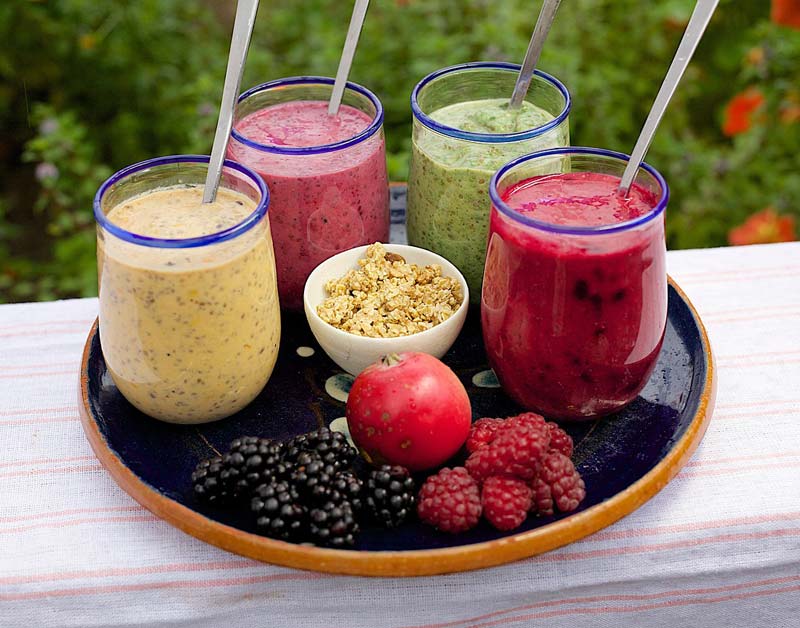
Sure, you could head to your neighborhood juice shop and order a $7 or $8 smoothie. Blending your own, however, is not only easier on your wallet, but you can customize to your heart's content and make several batches at a time.
Whether you're making a nutrient-dense meal replacement, a protein-packed workout booster or a sweet, chill treat, the flavor combinations are endless. You can use whichever ingredients you like or need to clear out of your refrigerator or freezer. All it takes is a little bit of thought.
A basic smoothie is quick and easy. It contains three essential elements: a liquid, a base (fresh or frozen fruits and vegetables) and a chill factor (ice or frozen fruit). Those simple components inspire all kinds of wonderfully tasty blends. Choose ingredients for nutrition and pleasure (yes, you can have both!) in equal measure, taking into account taste, texture and vibrant color. After all, nobody wants to drink anything that looks and tastes like the place where the plants came to die.
To take your blends to the next level, to maximize nutrient density and to amp up the "wow" flavor factor, check out this handy guide to help get you blending like a pro.
The building-block elements below are listed in the order in which you would add them to the blender. (For personal blenders in which you invert the cup onto a blade assembly, reverse this process.)
Step 1: Liquid
Pour liquids (1 to 2 cups) in first for efficient blending. Examples: coconut water, milk, juice, kefir, kombucha, herbal or green tea.
To add a little magic, sprinkle in spices, herbs, citrus zest, natural extracts and flavorings and sweeteners.
For a nutritional boost, sprinkle in superfood powders, chia, hemp, flax, green powders, protein powder or cold-pressed oils.
Step 2: Base
Add soft and hard produce, and fibrous foods such as nuts and dried fruits, then frozen fruits.
The heart of the base is 2 to 3 cups of fruits and vegetables (fresh, frozen, baked, steamed, dried), as well as raw and sprouted nuts and seeds (1/4 to 1/2 cup).
To taste, include an element of cream: avocado, banana, mango, cooked grains (1/4 cup), silken tofu, nut butter, raw nuts (such as cashews and blanched almonds, 1/4 to 1/2 cup) or yogurt (1/2 to 1 cup).
If you like greens, consider 1 to 2 cups. Examples: spinach, romaine, radish greens, collards, chard, kale, beet greens, dandelion, arugula, parsley, cilantro, mint or basil.
Step 3: Ice
The ice goes in last to help pull all the other ingredients down into the blades for even mixing.
![]()
Cool Tips
• Make ahead. Consuming smoothies right away maximizes nutrient value. However, for convenience, they can be refrigerated in sealed glass containers for a few hours or overnight. For longer storage, freeze in glass jars, allowing an inch of headspace for expansion of liquids. Defrost in the refrigerator, then shake or blend before serving.
• Flavor your ice. Freeze cubes of leftover fruit and vegetable juice, milk and tea. Use instead of plain ice for a flavor or nutrient boost or to approximate the magic of ice cream or sorbet.
• Freeze your vegetables. Our taste buds are temperature-sensitive, so 1/2 cup of frozen broccoli or cauliflower can be incorporated without altering the flavor of your smoothie.
![]()
Hot additions
• Warm it up. Adding foods such as fennel, cinnamon, ginger and cayenne not only balances cooling blends but also gives smoothies a nice kick, stimulates the lymphatic system and can help detoxify.
• Add a body bonus. Adding 1/2 teaspoon of probiotic powder or the contents of 1 probiotic capsule helps balance the natural sugar content of sweet smoothies, aids the digestive system and can help boost immunity. It is undetectable in a smoothie and a great way to get your daily dose.
• Drizzle in a healthful extra. Cold-pressed oils such as flaxseed, hemp, borage, avocado, coconut, macadamia, pumpkin seed and olive are healthful boosts. Start small, with just a teaspoon. Add gradually, typically up to about a tablespoon - just enough so you can't detect it.
![]()
Healthful ideas
• Rotate your greens. To avoid oxalic toxicity (which can deplete calcium from bones and teeth), blend a variety of greens. Start with mild leafy greens such as spinach, radish greens and kale. Work your way up to more pungent greens such as collard, chard, beet greens and arugula. Then introduce wild edibles such as dandelion greens.
• Watch your combos. If bloating is a concern, pay attention to food combining. Blending certain fruits and vegetables together is problematic for some people and not others. Adding too much fruit or sugar to blends, or drinking high-water-content foods after other concentrated foods, also can cause problems. Consult a registered dietitian or nutritionist.
• Juicing vs. blending. Juicing removes skins and piths, which is good for cleansing or recovery from acute illness, as it offers a nutrient-dense experience that accommodates gentler digestion. Blending retains all the nutrients in skins, piths and seeds; that kind of fiber slows down the assimilation of sugars, assists with bowel regularity and is thought to help eliminate toxins.


 Contact The Editor
Contact The Editor
 Articles By This Author
Articles By This Author